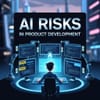Artificial intelligence is transforming the product development landscape, but it also introduces significant risks that need to be carefully managed. The main risk is a gradual transfer of product strategy from business leaders to technical systems, often without anyone deciding this should happen. Teams add "AI" and often report more output, not more learning, which can lead to over-trust in automated cues and under-practice of independent verification.
Product development teams face several challenges when integrating AI into their workflows. One major concern is biased or inaccurate outputs. AI systems can make mistakes or generate false information, known as "hallucinations," and replicate biases in their training data sets. This can lead to assumptions about customers and their needs that aren't accurate. For instance, an AI tool trained on a data set that includes references only to male professors might recommend a product designed to optimize performance for the average man, limiting accessibility for a large percentage of female users.
The AI product development process requires management by human engineers, and AI oversight is notoriously tricky. Overconfidence in AI can lead to creating polished-looking concepts that cannot be produced or function as depicted. To mitigate these risks, product managers and developers need to understand both the strengths and limitations of AI systems and review the AI's output to ensure accuracy and functionality.
To successfully integrate AI into product development, teams should focus on customer needs and expectations. Here are some strategies to consider¹ ²:
- Human Oversight: Maintain strong human oversight to review and verify AI recommendations, especially for critical decisions.
- Data Quality: Invest in data engineering and labeling, perform bias audits, and build a data exclusion checklist to clean legacy inputs.
- Explainable AI: Integrate explainable AI techniques to provide transparency into AI decision-making processes.
- Continuous Monitoring: Implement continuous monitoring pipelines with drift detection and schedule regular retraining cycles to ensure AI models remain aligned with business needs.
- Risk Management: Develop a comprehensive risk management framework that addresses technical, operational, and ethical risks associated with AI adoption.


